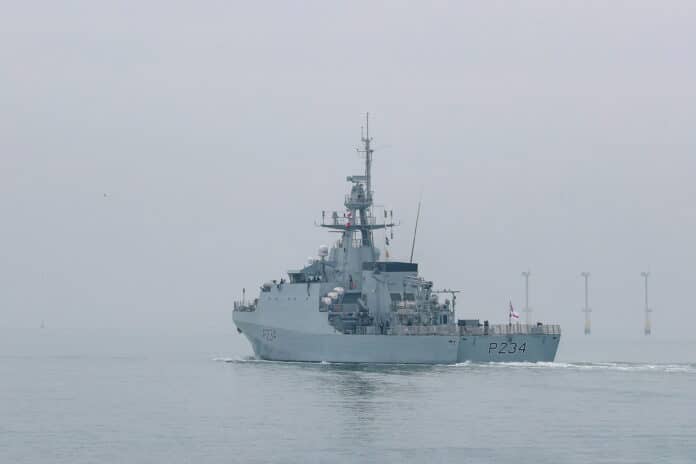
The Royal Navy’s newest Offshore Patrol Vessel HMS Spey was commissioned into the Fleet today (18 June) during a ceremony alongside the Ross-shire town of Invergordon.
Built on the River Clyde by BAE Systems, the ship is the fifth and final of the second- generation of River-class vessels built for the Royal Navy.
According to a press release issued by the Royal Navy, leaving the Clyde shipyard in October last year, HMS Spey has been undergoing a rigorous programme of operational sea training to ready her for action.
On Friday, June 18, however, Spey and her 45-strong crew were at their affiliated town of Invergordon where dozens of invited guests gathered to welcome her into active service with the Royal Navy.

During the commissioning guests were entertained by the Band of the Royal Marines Scotland while RAF submarine-hunting Poseidon aircraft from RAF Lossiemouth conducted a spectacular flypast to mark the occasion.
Minister for Defence Procurement, Jeremy Quin MP, said: “Today marks a significant milestone for the Royal Navy’s second generation of River Class vessels, as HMS Spey prepares to join her four sister ships to provide essential maritime security for the UK.
“Built on the River Clyde, HMS Spey symbolises vital industry expertise central to delivering the next-generation of naval capabilities.”
There are two generations of River-class ships serving with the Royal Navy.
The first – comprising HMS Tyne, Severn and Mersey – were constructed by Vosper Thorneycroft in Southampton and have been operating since the early 2000s, primarily helping to protect fishing stocks but also fulfilling general duties at home and abroad.
The second generation, which includes HMS Spey, were Clyde-built and are larger, faster and even more capable. HMS Forth is the UK’s permanent presence in the South Atlantic; HMS Medway is supporting British Overseas Territories in the North Atlantic and the Caribbean, while HMS Trent is in the Mediterranean and HMS Tamar is available for tasking by the UK Government.
At just over 90-metres long, the ships feature a flight deck large enough for a Royal Navy Merlin helicopter and room on board for up to 50 embarked Royal Marines.
This makes the second generation of the River-class incredibly versatile vessels capable of tackling a variety of missions from counter-piracy to disaster relief.
The River-class construction is estimated to have sustained 1,400 jobs at its peak with a supply chain spend of nearly £240M across the UK and Europe.
Attending the ceremony was Rear Admiral Simon Asquith OBE, the Royal Navy’s Commander Operations.
He said: “The Batch 2 Offshore Patrol Vessels are impressively flexible ships and are already making a real difference to current operations globally.
“As we speak, HMS Trent, HMS Forth and HMS Medway are providing sustained forward presence in some of the UK’s global areas of interest.
“The commissioning of Spey demonstrates a further development to the Royal Navy’s role in Global Britain where, later in the year in company with her sister ship Tamar, she will deploy to the Indo-Asian-Pacific region for the foreseeable future. Once deployed, they will work closely with allies and partners to support maritime security in the region.”
HMS Spey, the fifth and final River Class Batch 2 Offshore Patrol Vessel (OPV), departed BAE Systems’ shipyard in Glasgow on 28th October on her delivery voyage to her new home of Portsmouth Naval Base.
Check out Naval Library App to find out the specifications of River-class OPVs.




